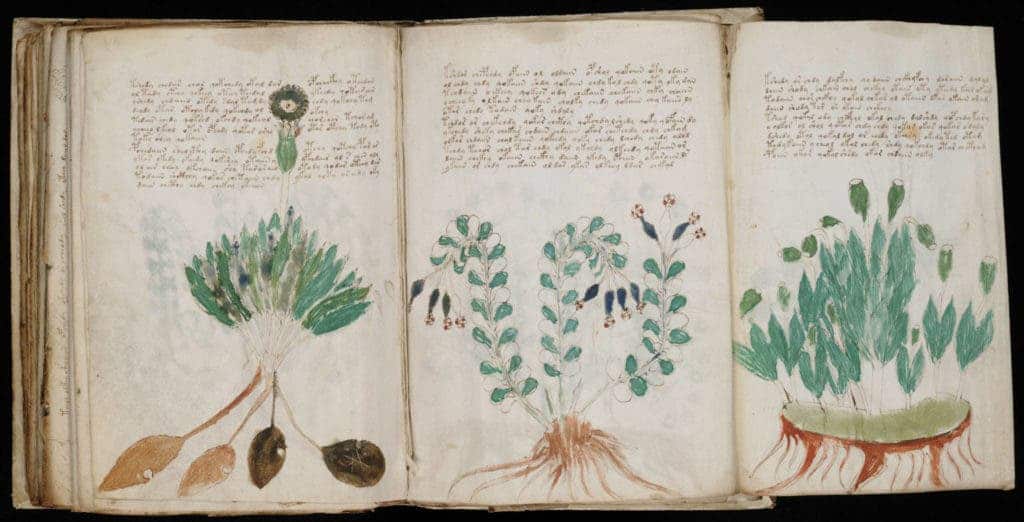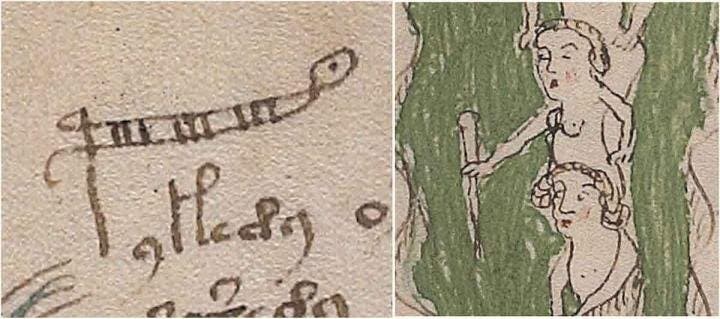
A researcher at the University of Bristol claims to have decoded the language and meaning of the Voynich Manuscript — a bizarre Medieval 200-page book written in alien-like glyphs. The book’s content has eluded some of the world’s foremost cryptologists and linguists for years. But Dr. Gerard Cheshire, a research assistant at Bristol, claims it took him only two weeks to decipher the world’s most mysterious book.
The Voynich manuscript: a herbal atlas, alchemy recipe, or an elaborate hoax
“I experienced a series of ‘eureka’ moments whilst deciphering the code, followed by a sense of disbelief and excitement when I realised the magnitude of the achievement, both in terms of its linguistic importance and the revelations about the origin and content of the manuscript,” Cheshire said in a statement.
The Voynich manuscript‘s history is as dubious as to its contents. In 1912, the cypher manuscript was found by a Polish book dealer named Wilfrid Voynich. The book is believed to have once belonged to Rudolf II (1576–
The 600-year-old book is one of the strangest and most mysterious tomes in the world. Many great minds have attempted to decipher its contents written in an unknown script alongside botanical, astronomical, biological, and pharmaceutical illustrations. Yet the book has kept its secrets well-hidden.
Voynich claimed that Roger Bacon — who was a 13th-century monk and philosopher — was the original author of the manuscript. Bacon is a controversial figure who was involved in all areas of science but also in the occult, as were most scholars of his time. In a work called The Mirror of Alchemy, Bacon mentions the creation of an elixir that he claimed could not only transmute metals and prolong life — a Philosopher’s Stone of sorts. The “true” procedure might have been concealed in the enciphered Voynich manuscript.
Another possible author is astrologer/alchemist John Dee. Some have even suggested that the whole thing is an elaborate hoax performed by someone trolling Emperor Rudolf’s propensity for alchemy or by Voynich himself, an astute collector but also a former convict. Voynich had previously served time as a political prisoner in Warsaw and Eastern Siberia, having escaped from both, before arriving in England with fake papers. It’s unlikely that Voynich made a forgery though since the vellum, or animal skin, on which the codex is written has been dated to the early 15th century.
Cheshire claims the book is written in an extinct language, known as proto-Romance, that predates French, Italian, Romanian, Portuguese, Spanish, Catalan, and Galician. By his interpretation, the Voynich is the only known surviving text written in proto-Romance. He even claims that he knows that the author — Dominican nuns who wrote the book as a reference source on behalf of Maria of Castile, Queen of Aragon.

“It is also no exaggeration to say this work represents one of the most important developments to date in Romance linguistics. The manuscript is written in proto-Romance—ancestral to today’s Romance languages including Portuguese, Spanish, French, Italian, Romanian, Catalan and Galician. The language used was ubiquitous in the Mediterranean during the Medieval period, but it was seldom written in official or important documents because Latin was the language of royalty, church and government. As a result, proto-Romance was lost from the record, until now,” Cheshire said.
“It uses an extinct language. Its alphabet is a combination of unfamiliar and more familiar symbols. It includes no dedicated punctuation marks, although some letters have symbol variants to indicate punctuation or phonetic accents. All of the letters are in lower case and there are no double consonants. It includes diphthong, triphthongs, quadriphthongs and even quintiphthongs for the abbreviation of phonetic components. It also includes some words and abbreviations in Latin,” he added.

Not everyone is convinced. The mystery of the Voynich manuscript has attracted all sorts of people, some not very credible, who each claimed they had ‘cracked’ the script. Sooner than later, each and every one of these claims was debunked. One of the most promising Voynich decoding attempts was performed last year by Canadian researchers at the University of Alberta. The research team wrote an AI algorithm that scanned the enigmatic text, suggesting it was written in Hebrew, and not “proto-Romance”.
Sorry, folks, "proto-Romance language" is not a thing. This is just more aspirational, circular, self-fulfilling nonsense. https://t.co/iyD66nmBRr
— Lisa Fagin Davis (@lisafdavis) May 15, 2019
Speaking to Ars Technica, Lisa Fagin Davis, executive director of the Medieval Academy of America, said Cheshire’s study uses flawed methods and shouldn’t really be taken seriously.
“As with most would-be Voynich interpreters, the logic of this proposal is circular and aspirational: he starts with a theory about what a particular series of glyphs might mean, usually because of the word’s proximity to an image that he believes he can interpret. He then investigates any number of medieval Romance-language dictionaries until he finds a word that seems to suit his theory. Then he argues that because he has found a Romance-language word that fits his hypothesis, his hypothesis must be right. His “translations” from what is essentially gibberish, an amalgam of multiple languages, are themselves aspirational rather than being actual translations,” Davis said.
“In addition, the fundamental underlying argument—that there is such a thing as one ‘proto-Romance language’—is completely unsubstantiated and at odds with paleolinguistics. Finally, his association of particular glyphs with particular Latin letters is equally unsubstantiated. His work has never received true peer review, and its publication in this particular journal is no sign of peer confidence.”
J. K. Peterson also offers an extensive list arguing against Cheshire’s interpretation, which he finds contentious.
-
there are a lot of nonsensical word combinations,
-
there’s almost no grammar,
-
the letter distribution is quite different from Romance languages (it would too long to discuss this aspect of the text, but take 4 as an example, which almost exclusively is at the beginnings of tokens—Cheshire relates it to “d”, and “9” which is usually at the end and sometimes at the beginning, but almost never in the middle, which he designates as “a”),
-
the words still match the drawings if the drawings are interpreted differently (which means the relationship isn’t proven yet),
-
some of the transliterated “words” don’t show any relationship to Romance word-structures (and the author neglected to explain how specific non-Romance words were derived), and
-
the same words (e.g., “na”) are sometimes interpreted differently.
Peterson adds that “Cheshire hasn’t given a satisfactory explanation of why a mid-15th-century scribe would use an undocumented proto-Italian script from c. 700 C.E. or earlier. And let’s be honest, the translations are semantically peculiar. The human mind is designed to construct meaning from small clues, to fill in the gaps, so it’s easy to read meaning into almost any collection of semi-related words, but it’s very difficult to confirm anything that doesn’t quite hold together in normal ways.”
In the future, Cheshire wants to translate the entire manuscript and compile a lexicon, an undertaking which will require considerably more time than “two weeks”, as well as significant funding. But by the looks of it, this will likely not be the last time we hear from someone claiming to have “cracked” the Voynich manuscript.
For now, whether it is an occult treaty, an elaborate hoax, or something completely different, the Voynich Manuscript still holds its secrets.
Update: The University of Bristol issued a statement saying that Cheshire’s work was not affiliated in any way with the university.
Yesterday the University of Bristol published a story about research on the Voynich manuscript by an honorary research associate. This research was entirely the author’s own work and is not affiliated with the University of Bristol, the Faculty of Arts or the Centre for Medieval Studies.
The paper was published in the journal ‘Romance Studies’ following a double blind peer review process in line with journal policy, a process used to validate the research quality of a study.
When a member of our academic community has a paper published in a peer-reviewed journal, the University’s Media Team will determine whether the findings are of public interest. If they are, the team will communicate the research to the media and on our University website.
Following media coverage, concerns have been raised about the validity of this research from academics in the fields of linguistics and medieval studies. We take such concerns very seriously and have therefore removed the story regarding this research from our website to seek further validation and allow further discussions both internally and with the journal concerned.


